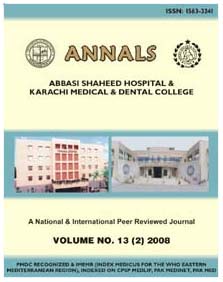| THE IMPACT OF EXTENDED SPECTRUM
BETA LACTAMASE PRODUCING ORGANISMS ON THE MANAGEMENT OF INFECTIONSs
1NAZ JAMEEL, 2ABDULLAH ABDUL WAHEED, 2ALI
RAZA, 2ANAAS KASAR
ABSTRACT
Objective: To determine
the frequency of extended spectrum ß-lactamase producers and their
drug resistance pattern.
Material and Methods: A total 128 isolates of E. coli and K. pneumoniae were obtained from different clinical specimens mostly urine (57%) and pus (33.6%), received in the Microbiology lab of Abbasi Shaheed Hospital, Karachi, Pakistan. These isolates were from both inpatient department (IPD) and outpatient department (OPD). ESBL detection and antimicrobial susceptibility testing were done by Phenotypic Confirmatory Disc Diffusion Test (PCDDT), according to Clinical Laboratory and Standards Institute (CLSI 2010).
Results: It was found that 21.9% (28/128) of E.
coli and K. pneumoniae isolates were positive for ESBL production
in different clinical samples. The maximum number of ESBL producing
isolates was from outpatients (67.85%) followed by inpatients (32.14%).
Conclusion: This study indicates that there is
a high multi drug resistance and high frequency among the strains
of E. coli in both inpatients and outpatients. Further drug resistance
surveillance and molecular characterization of ESBL isolates are
necessary in our country.
Key words: Escherichia coli, Klebseilla pneumonia,
Extended spectrum beta lactamase, Phenotypic confirmatory disc diffusion
test.
|

